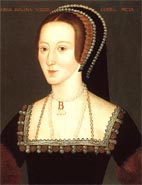
WHATS IN A NAME
(A short History of Pub Signs)
Over the last 500 years the Queens Head has served
the community but It was not until the
last century that it began to look the way we see it today.
In Anne Boleyn’s day the Queens Head would have been
little more than a simple shop.
In the 16th century almost everyone brewed their own Ale and the pub owner
would have used his home to sell off excess beer made on the premises.
The customers would have almost exclusively been farm workers and local
traders and it was not until the rise of the breweries in the 17th century
that it would have opened its doors to allow customers to buy beer made
off the premises.
Anne Boleyn (c.1504 - c.1536)
Hanging outside The Queens Head Pub in Haverhill is a picture of Anne Boleyn the Tudor Queen the pub is named after. But who was Anne Boleyn and what became of this famous Queen? Haverhill Life investigates.
Anne was the second wife of King Henry VIII and the mother
of Queen Elizabeth I.
There is some dispute over the year in which Anne was born, with a date
between 1501 and 1507 most likely. Anne's father was the courtier and
diplomat Sir Thomas Boleyn and her mother, Elizabeth, was the daughter
of the Duke of Norfolk. Anne spent some of her childhood at the court
of the Archduchess Margaret in the Netherlands and then at the French
Britain has a unique heritage in its Pub signs: a record of its history and the people who made it. Inn signs depict everything, from battles to inventions, from sporting heroes to royalty.
The origin of inn signs goes back to the Romans. The 'Tabernae'
would hang vine leaves outside to show that they sold wine - in Britain,
as vine leaves are rare (due to the climate!), small evergreen bushes
were substituted. One of the first Roman tavern signs was the 'Bush'.
Early pubs hung long poles or ale stakes, which might have been used to
stir the ale, outside their doors. If both wine and ale were sold, then
both bush and pole would be hung outside.
The naming of inns and pubs became common by the 12th century. With pub
names came pub signs - as the majority of the population could not read
or write. In 1393, King Richard II passed an Act making it compulsory
for pubs and inns to have a sign (his own emblem the 'White Hart' in London)
in order to identify them to the official Ale Taster. Ever since then,
inn names and signs have reflected, and followed, British life at that
time.
Before King Henry VIII and the Reformation, many had a religious
theme, for example 'The Crossed Keys' , the emblem of St. Peter. When
Henry split with the Catholic church, names were changed from religious
themes to 'The Queen’s Head' or 'The Rose & Crown' etc.
The 'Red Lion' is probably the most common name for a pub and originates
from the time of James I and VI of Scotland who came to the throne in
1603. James ordered that the heraldic red lion of Scotland be displayed
on all buildings of importance - including pubs!
Many signs have royal links: for instance, most 'White Lion' inns date
from the time of Edward IV and the 'White Boar' was the emblem of Richard
III.
Pubs are also named after famous people in history, for example, The Duke
of Wellington and Shakespeare.
More recently, social and industrial change has been reflected in pub names, for example 'The Railway' . Sport is well represented with names like 'The Cricketers' . Infamous goings-on are also remembered: for example, 'The Smugglers Haunt' and 'The Highwayman'!

court. On her return to England she was appointed a lady-in-waiting
to Queen Katherine, wife of Henry VIII.
Anne's striking looks and sophisticated manners earned her many admirers
at court, including the King. He had already had an affair with Anne's
sister Mary when he began to pursue Anne. She and her family were given
titles and gifts. But Anne resisted the King until his divorce from Katherine
was imminent. When Anne and Henry were secretly married in January 1533
she was already pregnant. She was crowned Queen in June. She was never
popular beyond the court, partly because she was an advocate of the reformation
of the church.
Their daughter Elizabeth was born in September 1533. Henry was desperate
for a male heir and his interest in Anne began to cool. Two more pregnancies
ended in miscarriage, in the summer of 1534 and in January 1536, when
the baby was a boy. Henry became convinced the marriage was cursed.
On 2 May 1536, Anne was arrested. She was accused of adultery with her
own brother and four commoners - they were all tried and convicted of
treason by Anne's uncle, the Duke of Norfolk. On 19 May Anne was beheaded
at the Tower of London - the first English queen to be publicly